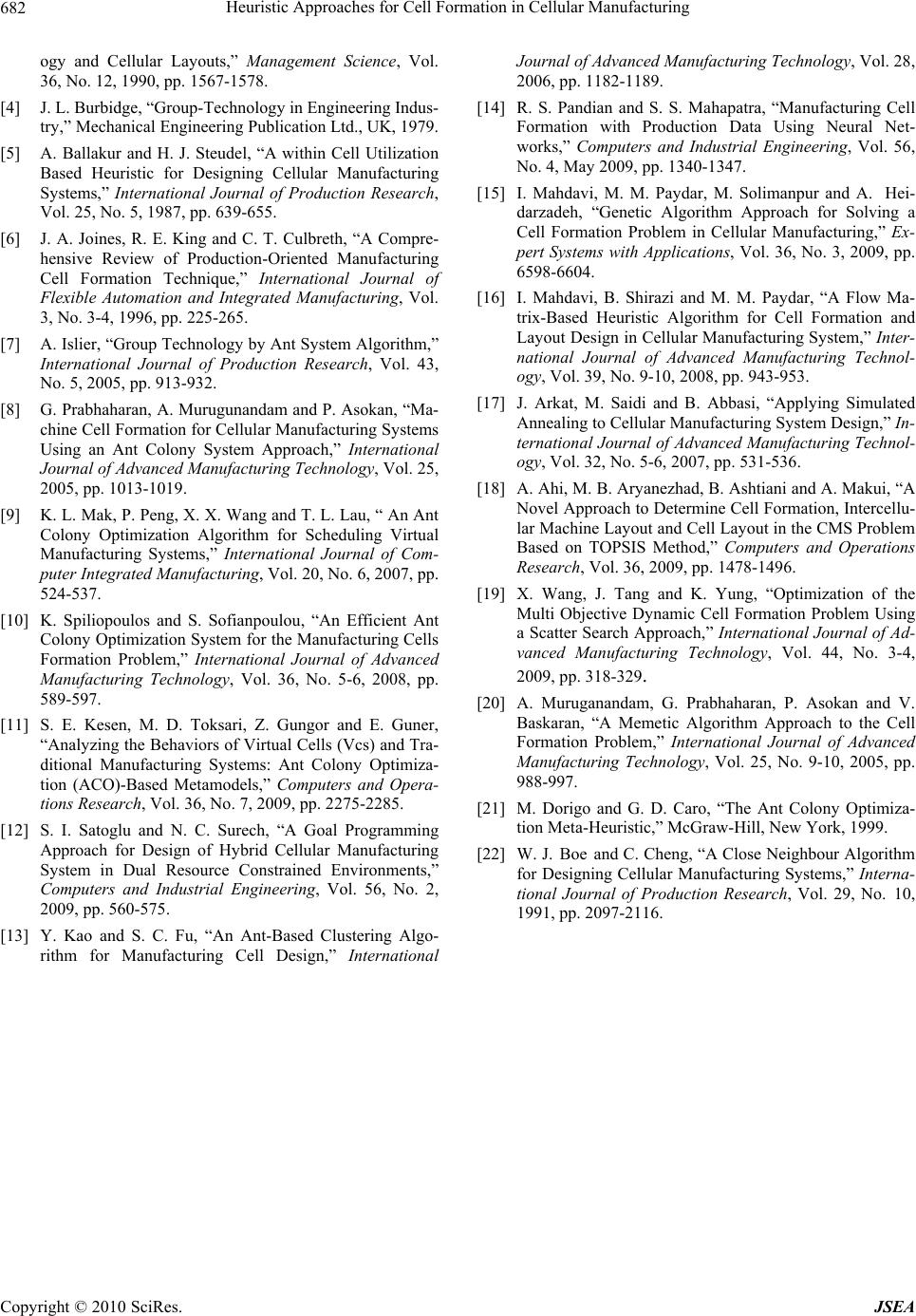
Heuristic Approaches for Cell Formation in Cellular Manufacturing
Copyright © 2010 SciRes. JSEA
682
ogy and Cellular Layouts,” Management Science, Vol.
36, No. 12, 1990, pp. 1567-1578.
[4] J. L. Burbidge, “Group-Technology in Engineering Indus-
try,” Mechanical Engineering Publication Ltd., UK, 1979.
[5] A. Ballakur and H. J. Steudel, “A within Cell Utilization
Based Heuristic for Designing Cellular Manufacturing
Systems,” International Journal of Production Research,
Vol. 25, No. 5, 1987, pp. 639-655.
[6] J. A. Joines, R. E. King and C. T. Culbreth, “A Compre-
hensive Review of Production-Oriented Manufacturing
Cell Formation Technique,” International Journal of
Flexible Automation and Integrated Manufacturing, Vol.
3, No. 3-4, 1996, pp. 225-265.
[7] A. Islier, “Group Technology by Ant System Algorithm,”
International Journal of Production Research, Vol. 43,
No. 5, 2005, pp. 913-932.
[8] G. Prabhaharan, A. Murugunandam and P. Asokan, “Ma-
chine Cell Formation for Cellular Manufacturing Systems
Using an Ant Colony System Approach,” International
Journal of Advanced Manufacturing Technology, Vol. 25,
2005, pp. 1013-1019.
[9] K. L. Mak, P. Peng, X. X. Wang and T. L. Lau, “ An Ant
Colony Optimization Algorithm for Scheduling Virtual
Manufacturing Systems,” International Journal of Com-
puter Integrated Manufacturing, Vol. 20, No. 6, 2007, pp.
524-537.
[10] K. Spiliopoulos and S. Sofianpoulou, “An Efficient Ant
Colony Optimization System for the Manufacturing Cells
Formation Problem,” International Journal of Advanced
Manufacturing Technology, Vol. 36, No. 5-6, 2008, pp.
589-597.
[11] S. E. Kesen, M. D. Toksari, Z. Gungor and E. Guner,
“Analyzing the Behaviors of Virtual Cells (Vcs) and Tra-
ditional Manufacturing Systems: Ant Colony Optimiza-
tion (ACO)-Based Metamodels,” Computers and Opera-
tions Research, Vol. 36, No. 7, 2009, pp. 2275-2285.
[12] S. I. Satoglu and N. C. Surech, “A Goal Programming
Approach for Design of Hybrid Cellular Manufacturing
System in Dual Resource Constrained Environments,”
Computers and Industrial Engineering, Vol. 56, No. 2,
2009, pp. 560-575.
[13] Y. Kao and S. C. Fu, “An Ant-Based Clustering Algo-
rithm for Manufacturing Cell Design,” International
Journal of Advanced Manufacturing Technology, Vol. 28,
2006, pp. 1182-1189.
[14] R. S. Pandian and S. S. Mahapatra, “Manufacturing Cell
Formation with Production Data Using Neural Net-
works,” Computers and Industrial Engineering, Vol. 56,
No. 4, May 2009, pp. 1340-1347.
[15] I. Mahdavi, M. M. Paydar, M. Solimanpur and A. Hei-
darzadeh, “Genetic Algorithm Approach for Solving a
Cell Formation Problem in Cellular Manufacturing,” Ex-
pert Systems with Applications, Vol. 36, No. 3, 2009, pp.
6598-6604.
[16] I. Mahdavi, B. Shirazi and M. M. Paydar, “A Flow Ma-
trix-Based Heuristic Algorithm for Cell Formation and
Layout Design in Cellular Manufacturing System,” Inter-
national Journal of Advanced Manufacturing Technol-
ogy, Vol. 39, No. 9-10, 2008, pp. 943-953.
[17] J. Arkat, M. Saidi and B. Abbasi, “Applying Simulated
Annealing to Cellular Manufacturing System Design,” In-
ternational Journal of Advanced Manufacturing Technol-
ogy, Vol. 32, No. 5-6, 2007, pp. 531-536.
[18] A. Ahi, M. B. Aryanezhad, B. Ashtiani and A. Makui, “A
Novel Approach to Determine Cell Formation, Intercellu-
lar Machine Layout and Cell Layout in the CMS Problem
Based on TOPSIS Method,” Computers and Operations
Research, Vol. 36, 2009, pp. 1478-1496.
[19] X. Wang, J. Tang and K. Yung, “Optimization of the
Multi Objective Dynamic Cell Formation Problem Using
a Scatter Search Approach,” International Journal of Ad-
vanced Manufacturing Technology, Vol. 44, No. 3-4,
2009, pp. 318-329.
[20] A. Muruganandam, G. Prabhaharan, P. Asokan and V.
Baskaran, “A Memetic Algorithm Approach to the Cell
Formation Problem,” International Journal of Advanced
Manufacturing Technology, Vol. 25, No. 9-10, 2005, pp.
988-997.
[21] M. Dorigo and G. D. Caro, “The Ant Colony Optimiza-
tion Meta-Heuristic,” McGraw-Hill, New York, 1999.
[22] W. J. Boe and C. Cheng, “A Close Neighbour Algorithm
for Designing Cellular Manufacturing Systems,” Interna-
tional Journal of Production Research, Vol. 29, No. 10,
1991, pp. 2097-2116.